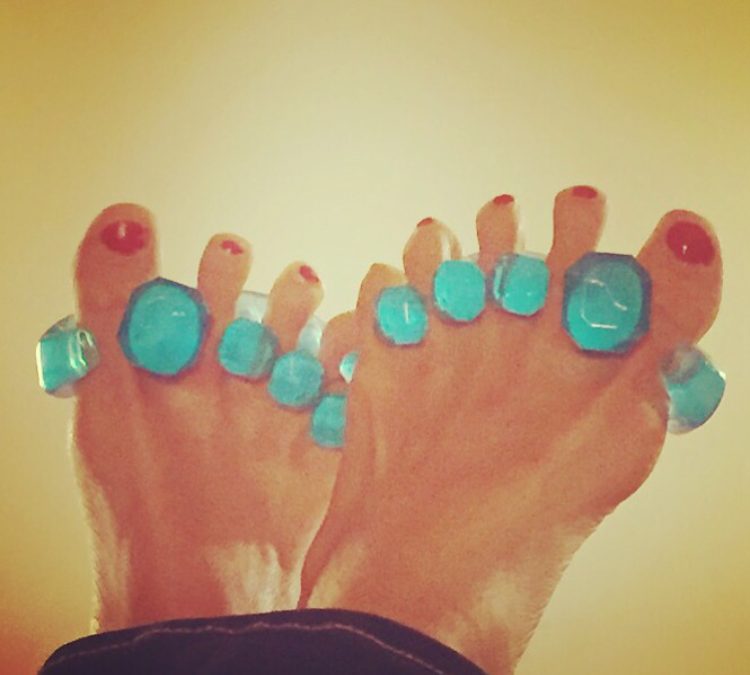I am not normally the woman who posts photos of her feet on Facebook. But for the sake of education, I’m not afraid! Yes, that’s me sporting the Gems model of Yogatoes…it looks horrifying, but it actually can feel quite good on your feet.
I’d never in my life heard of Yogatoes before this past April. In the past month, however, I’ve had four different clients come in and tell me that they had purchased this product and felt that it was helping not only their foot pain, but their balance, posture and alignment, so naturally I had to check it out. There are a lot of expensive, trendy products out there that provide minimal benefit or can turn out to be harmful, and I am very selective in my endorsement of products. I will only recommend those items which I have product tested personally and which I truly believe will benefit others. I also like to learn a bit about the company, its philosophy and beliefs and whether or not they are in line with my practice. So here’s what I learned from a month-long trial of Yogatoes:
Yogatoes are toe separators made from plastic or silicone and gel, and are designed to create more space between your toes and stretch the intrinsic muscles between your metatarsals. Two sets come in each pack, one for each foot, and each device is comprised of four attached toe separators and material to hold the device on your foot. They actually were invented in 2003 by Frederic Ferri, yoga practitioner and instructor, inventor of yoga products since the 1970s, and founder of his company, YogaPro. The basic “yoga” aspect of Yogatoes is that the product strives to address the yogic concept that the foot is the foundation of the entire body. A portion of any decent yoga class focuses on the feet—centering your weight and balance, spreading your toes to accept equal responsibility for your weight, and grounding yourself.
There are several different models of Yogatoes to choose from, ranging from those that appear to be slightly more rigid and aggressive, with a piece that goes over the top of your toes to hold the separators in place, and some that are a little more forgiving. I went with the Yogatoes Gems—a silicone gel separator that was softer and consisted of just the plantar piece without the top portion—because I thought I would freak out with my toes locked into a contraption, and also because the Gems look like beautiful blue mermaid jewels, which makes them a little more fun to wear.
The company recommends that you start slowly, with maximum wearing time of 10 to 15 minutes per day to start, and gradually increase wearing time as tolerated, which is sensible advice for any product that may alter your weightbearing and gait mechanics, including but not limited to orthotics and insoles. Your feet are designed to be a sensitive and reactive part of your body. The catch: You can’t walk around in YogaToes, and you have to wear them barefoot. They are too bulky to fit in shoes or sandals. These factors were a big “oh” for me as I’ve got stuff to do, and initially were a big downside of the product for me. I am used to working with products such as Superfeet, Spenco insoles, and single gel toe separators that operate dynamically, i.e. during weightbearing and gait. But the “duh” part that came to me is that when you are weightbearing, you are reflexively contracting your foot intrinsics (the deep muscles between the metatarsal bones of your foot). So something like a Dr. Scholl’s gel toe spacer to prevent bunions is mostly mechanically corrective, maintaining the space and just blocking the big toe from drifting laterally. They may slow down progression but they really are not stretching anything or doing anything more than temporary to change the mechanics. And I have seen people with severe toe issues crush those suckers after just a few hours of wear.
I actually gave up the Yogatoes for a couple of weeks and was tempted to write them off as not worth the time investment until I figured out how to work them into my life. I think that process of figuring out how to work them into life probably would be the most challenging part of putting them to regular use for a lot of people. I am on my feet for most of every day, but there is a chunk of time every evening when I crash out on the couch with my laptop to get some of my PT documentation done, and it worked out to be a good time to test out the Yogatoes. And the product testing actually benefitted my organization, in that forcing myself to try out the Yogatoes made me stay up a little later to catch up on my work. So even if you think that other people sit down all the time but YOU never do, chances are that you do at some point. Or at the least you do go to bed at some point, and that would be a good time to throw on the Yogatoes for 10 minutes. Remembering to use them also was part of getting started, and I had to employ the “if it were a snake it would bite me” method and leave them in plain view on the coffee table, where they served the dual purpose of horrifying anyone else in the household who noticed them.
So here’s what happened with the Gems: At first, when I put them on for the introductory period of 10 to 15 minutes they would hurt like a mothafucka for a few minutes, and then my feet would suddenly relax and stretch out and feel tingly and amazing, and make me just want to smile and stretch. That must be the other part of the “yoga” in “Yogatoes.” They feel absolutely terrific on tight runner/PT feet. I currently have no specific foot problems but I have had your typical barrage of runner’s problems in the past, including but not limited to plantar fasciitis, Achilles and posterior tibial tendinitis, and bruised met heads from hitting the rocks while trail running, and I have been preventing progression of a mild asymptomatic bunion on my left foot since my 20’s. I’m sure you’re loving all these details. I also am on my feet with work and the kids all freaking day. So I imagine they would feel great to anyone who has a physically demanding occupation as well as to anyone who is in any kind of restrictive shoe for sports—dancers, runners, skiers, and hockey players to name a few.
My wearing tolerance is up to about 45 minutes, which is the point where I can’t stand it for another second and rip them off my feet. I am noticing some differences throughout that time period, for example that the Gems feel great when I first put them on, and now I actually look forward to them. They do gradually start to ache and tingle in a “hurts so good” way over a period of probably 25 minutes, but when this progresses to actual discomfort it’s time to take them off. For the sake of education I did grit my teeth and take the pain for a little longer a few nights ago just to see what would happen, and the next morning I did notice mild muscle soreness in my intrinsics, as if my feet had some sort of workout. So the Yogatoes are actually doing something. I do think slow progression is key, particularly for anyone with moderate to severe bunions or hammertoes, as these conditions represent years of contracture and the intrinsic stretching would be helpful, but could make your feet very sore initially.
When I take them off, I do feel as if my feet are in better contact with the floor and that my weightbearing is more symmetrical and balanced, and balance and symmetry are two of my favorite concepts. Does it last forever? No. But it probably does last the rest of the evening, since I am falling asleep by 10 pm (yes, I know, I am the life of the party). So in light of how long the effects last, it makes more sense to me to use them at the end of the day, after a day of stress to your feet, so that the effects last a little longer.
Will Yogatoes fix all your foot problems? I do not yet have any clients who have been using them long term on whom I can base my predictions, but PT logic dictates that Yogatoes by themselves will not fix it all. A passive treatment for an hour or so a day followed by another 23 hours of bad habits will do nothing for you. Yogatoes, however, feel great and have the potential to be an excellent adjunct to treatment and also helpful in getting you on the right track. Any chronic problem represents years of various contributing factors causing stress to your body, and managing or fixing a chronic problem requires commitment to lifestyle change. So if you think you can pop in Yogatoes for an hour at night and then wear high heels or flip flops all day, you’ve got it wrong. A good foot program will include changing your footwear, stretching, strengthening and what I call “brain retraining” exercises, that change where and how you are weightbearing, and possibly may address alignment factors of your spine and hips that are causing you to stand and walk a certain way. People with severe foot issues and/or nerve irritation from their spine may have trouble initially with stretching and strengthening exercises because their feet are so tight. YogaToes, however, are a gentle, gradual, noninvasive way to give you a little foot flexibility to get started with long term change and preventing progression of chronic issues, and are great to relieve foot tension at the end of the day; but, like the rest of your program, you need to be committed and stick with it. An ideal foot program in my mind might be wearing the YogaToes for 10 or 15 minutes first thing in the morning and at the end of the day, and immediately follow up each wearing period with stretching, strengthening and appropriate footwear.
Recommendation: Absolutely worth a try. They may not work for everyone but at $29.95 to $39.95, they are a reasonably priced, non-invasive option for foot pain as well as spinal alignment issues. And if they’re too uncomfortable, you can wash them and use them to hold jewelry or toothbrushes. www.yogapro.com
–Kathleen Doehla, M.S. P.T.

